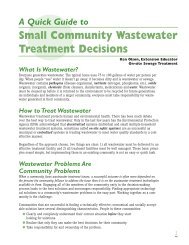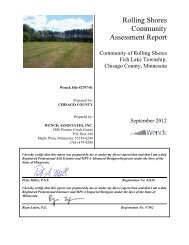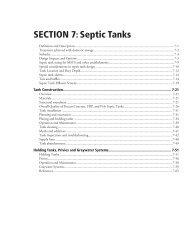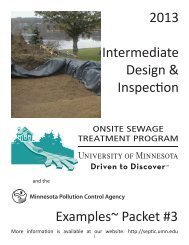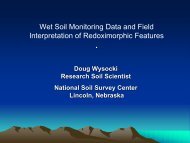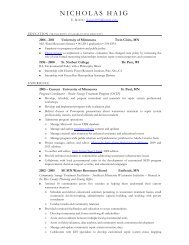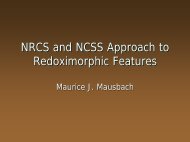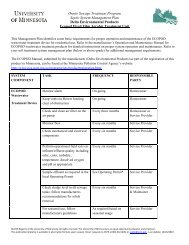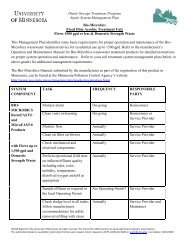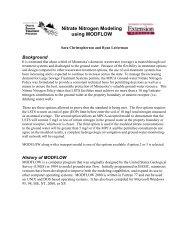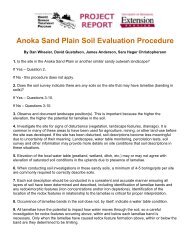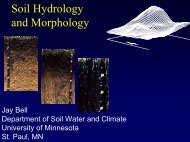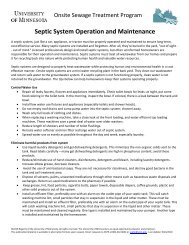MPCA Design Guidance for Large Subsurface Wastewater ...
MPCA Design Guidance for Large Subsurface Wastewater ...
MPCA Design Guidance for Large Subsurface Wastewater ...
Create successful ePaper yourself
Turn your PDF publications into a flip-book with our unique Google optimized e-Paper software.
Wisconsin Department of Commerce Web Site (see Table 4): http://commerce.wi.gov/sb/docs/sb-<br />
PowtsManualAtGrade.pdf<br />
EPA Onsite <strong>Wastewater</strong> Treatment System Manual:<br />
www.epa.gov/ORD/NRMRL/Pubs/625R00008/625R00008totaldocument.pdf<br />
3. Preliminary site evaluation (complete Attachment 3)<br />
The next step involves completing a general evaluation of the proposed LSTS site(s). It is recommended<br />
that this preliminary site evaluation be per<strong>for</strong>med not only to determine the suitability of the potential<br />
LSTS site(s), but also to justify the expense of more detailed and time-consuming soils and<br />
hydrogeologic evaluations.<br />
The purpose of the preliminary site evaluation is threefold:<br />
1) to screen the area, or subdivision property, <strong>for</strong> potentially suitable LSTS sites, dependent on<br />
readily available soils and ground water in<strong>for</strong>mation<br />
2) to use this in<strong>for</strong>mation to determine whether a LSTS is a feasible method of wastewater<br />
treatment/disposal <strong>for</strong> the subdivision development<br />
3) to determine the concerns that may be associated with the proposed LSTS site(s)<br />
The four primary concerns that may be associated with a proposed LSTS site(s) include:<br />
1) Soil suitability (or the soil’s long-term hydraulic acceptance rate).<br />
2) Long-term maintenance of an unsaturated treatment zone.<br />
3) Compliance with the <strong>MPCA</strong> Nitrogen Policy.<br />
4) Impact of phosphorus to nearby surface waters.<br />
In general, the preliminary site evaluation will consist primarily of a desktop review of readily available<br />
in<strong>for</strong>mation. It is suggested that the designer seek out and obtain published soils and hydrogeologic<br />
in<strong>for</strong>mation <strong>for</strong> the area. If some relevant in<strong>for</strong>mation is not available, it is recommended that the<br />
designer make conservative assumptions <strong>for</strong> the data not found based on his/her best professional<br />
judgment.<br />
The end result of the preliminary site evaluation should lead to a conclusion as to whether the more sitespecific<br />
soil and hydrogeologic evaluations should be pursued <strong>for</strong> a proposed LSTS site. If one or more<br />
of the four concerns listed above appears to be insurmountable, perhaps a different LSTS site or a<br />
different wastewater treatment method should be pursued as opposed to conducting an expensive,<br />
detailed investigation of the current site. If the decision is made to investigate the proposed site further,<br />
it is recommended that the detailed evaluation initially focus on the area of concern that represents the<br />
most environmental consequence.<br />
The preliminary site evaluation may become an iterative process. Based on available in<strong>for</strong>mation, the<br />
desktop assessment may suggest that evaluation of the proposed LSTS site be discontinued and another<br />
site be pursued. This cycle may repeat itself several times until the most acceptable LSTS location is<br />
found on a given parcel. For this reason, it is recommended that platting of residential subdivisions be<br />
deferred until the ideal LSTS location is found.<br />
The designer should obtain as much of the following general in<strong>for</strong>mation as possible during the<br />
preliminary site evaluation. It is recommended that this in<strong>for</strong>mation be evaluated to assess the<br />
significance of the four areas of concern listed above.<br />
County soil survey in<strong>for</strong>mation (http://websoilsurvey.nrcs.usda.gov/app/)<br />
• soil texture and structure<br />
• soil permeability<br />
• depth to redoximorphic features<br />
<strong>Design</strong> <strong>Guidance</strong> <strong>for</strong> <strong>Large</strong> <strong>Subsurface</strong><br />
Minnesota Pollution Control Agency<br />
<strong>Wastewater</strong> Treatment Systems April 2010<br />
7



